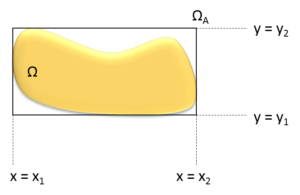The Cartesian Transformation Method (CTM) was proposed by Khosravifard and Hematiyan [1] for numerical integration in meshfree analysis. The main idea is to transform a domain integral into a double integral.
Let us take a 2D integral as an example
$ I = \int_{\Omega} F(x,y) d\Omega$,
where F(x,y) is an arbitrary function being defined in domain $\Omega$. Next, we define an auxiliary domain $\Omega_A$ that contains the original domain $\Omega$ and a new function G(x,y) that satisfies
$G(x,y) = F(x,y), where ~ (x,y) \in \Omega $
$G(x,y) = 0, where (x,y) ~ \notin \Omega $

Without loss of generality, the auxiliary domain $\Omega_A$ can be chosen as a rectangular domain, see Figure 1. The integral I is rewritten by
$I = \int_{y_1}^{y_2}\left[\int_{x_1}^{x_2}G\left(x,y\right) dx \right]dy = \int_{y_1}^{y_2}H\left(y\right)dy$,
where
$ H(y) = \int_{x_1}^{x_2} G (x,y) dx $.
Now, the domain integral I has been transformed into a double integral, which can be conducted using 1D Gaussian quadrature.
References
[1] A. Khosravifard and M. H. Hematiyan (2010). A new method for meshless integration in 2D and 3D Galerkin method. Engineering Analysis with Boundary Elements 34(1): pp. 30-40.
